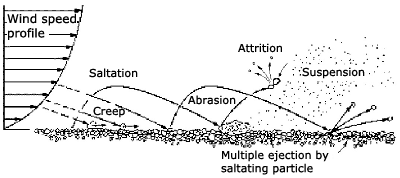Wind
There are 3 primary ways that wind can erode soil. You have creep which is when particles that are to big to be lifted by the wind are pushed along the ground by it. These particles tend to dislodge other ones and cause further erosion along the winds path.
Then you have saltation which is when particles of soil are briefly suspended into the air but will drop back down to the surface of the ground. The impact of the soil particles as they drop back to the surface causes them to breakdown into smaller particles which can be carried by the wind.
Finally we have suspension which is when particles less then .1 mm in diameter can be carried by the wind long distances. This stage of wind erosion is one of the most visible and awe inspiring forms of it that we can experience. The images from the Dust Bowl are the most visible example of this.
The amount of erosion that happened during the Dust Bowl is estimated to have damaged over 80% of the High Plains region. By 1938 over 5 inches of topsoil had been lost on 10 million acres and another 2.5 inches was lost on another 13 million acres.
The amount of erosion that happened during the Dust Bowl is estimated to have damaged over 80% of the High Plains region. By 1938 over 5 inches of topsoil had been lost on 10 million acres and another 2.5 inches was lost on another 13 million acres.
Despite all our efforts to fight soil erosion and all we have learned over the years it is still a issue we deal with today.
Water
Water erosion is a common problem facing farmers, ranchers, roads and anything that is built on soil. There are four types of erosion that occur from water, sheet, rill, gully and splash erosion.
Sheet erosion is when water move across the soil surface in a smooth even layer of water. It is not a very powerful form of erosion and will only remove a thin layer of soil. The caveat to that is the water will remove soil from a large area and that can add up quickly when you have large areas of bare soil cropland.
Rill erosion is the next step up on the water erosion list. You get rill erosion when the even coverage of sheet erosion coalesces into thin streams of water that cut deeper into the soil profile. They can create a spider web effect across a bare crop field that looks like the picture to the right.
Gully erosion is created when rills run together and slope increases which causes the water to dig down into the soil and create a wide, deep channel. There is some confusion sometimes about when it is a rill and when it is a gully. A good rule of thumb to follow is that when you can smooth it out easily then it's a rill if you can't then it's a gully.
Splash erosion occurs during weather events when rain drops impact the soil and can fling soil particles up to 3 feet from the impact point. In the center of a field this is not much of issue but it can cause erosion at the edges.
So now that I have covered the basic ways erosion happens in nature it should give you a better idea how it can happen to you. You have to understand how erosion works so that it can be avoided when you are trying to build a sustainable life. Erosion if not properly planned for can ruin months of work in one bad storm so it is important to know your land and the soils that are on it.
Stay tuned for more Science of Sustainability topics









